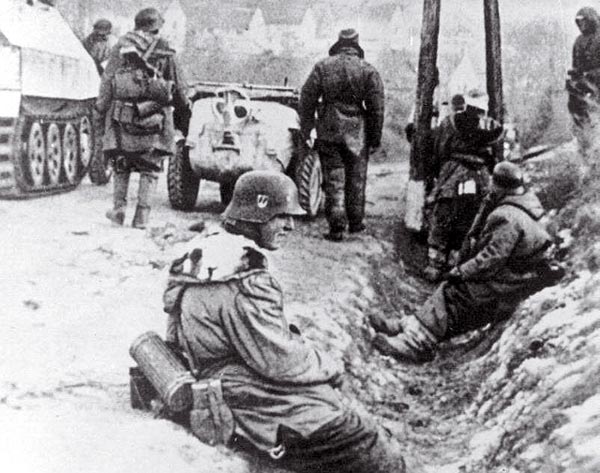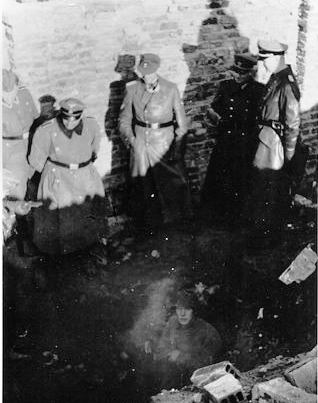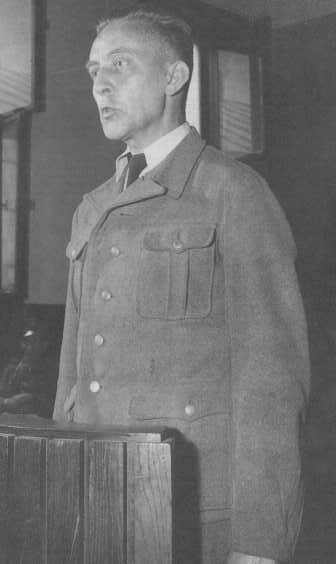Holocaust Education & Archive Research Team |
|
Occupation German Occupation of Europe Timeline
-
[The Occupied Nations]
Poland Austria Belgium Bulgaria Denmark France Germany Greece Hungary Italy Luxembourg The Netherlands Norway Romania Slovakia Soviet Union Sudetenland | |||
Jürgen Stroop
The son of a policeman, Josef Stroop, was born on 26 September 1895 in Detmold, Germany, but he later changed his name in honour of his deceased son in 1941. During World War One Stroop served in several infantry regiments at the front and won an Iron Cross 2nd Class. He was also wounded in action.
Stroop joined the SS on 1 July 1932 and received SS number 44611, he was admitted into the Nazi Party shortly thereafter on 1 September 1932. Stroop was promoted to SS-Hauptsturmfuhrer on 8 March 1934, to SS- Sturmbannfuhrer on 20 April 1935 and to SS-Obersturmbannfuhrer on 20 April 1936.
During the 1930’s he attended various leadership courses and commanded several General SS units in Germany proper. He was promoted to SS-Standartenfuhrer on 12 September 1937 and to SS-Oberfuhrer on 10 September 1939.
From 7 July to 15 September 1941 Jurgen Stroop served in combat on the eastern front with the 3rd SS Totenkopf Infantry Regiment of the SS Division “Totenkopf,” during the fighting he was awarded a Clasp to the Iron Cross 2nd Class and an Infantry Assault Badge in Bronze. Stroop served in the Sudetenland, after the occupation of Poland in September 1939 Stroop was transferred to Poznan as head of the German Selbschutz – self defence units of ethnic Germans.
Stroop was then promoted to SS-Brigadefuhrer on 16 September 1942 and assigned as an Inspector of the Sipo and SD of the Higher SS and Police Leader for Russia South, where he helped secure a key logistical route through October 1942.
He then briefly commanded an SS garrison at Kherson before becoming SS and Police Leader for Lemberg (Lvov) in February 1943. From that position he moved to Warsaw on 18 April 1943. Franz Konrad the SS officer in charge of the Werterfassung in von Sammern’s headquarters gave testimony that related to the first day of the aktion:
“A week before Easter 1943 – it was a Sunday morning – SS und Polizeifuhrer von Sammern convened a meeting of the heads of the Security Police, Obersturmbannfuhrer Hahn, the commanders of the SS units in Warsaw, the commanders of the cavalry and infantry reserve units, the commanders of the Sipo (Security Police) and the Orpo (Regular Police) and the officers in his headquarters (myself among them).
At this meeting we were notified that on Monday he intended to transfer out the Jews who still remained in the Warsaw ghetto. During the discussion about the appropriate time for sending the various SS and police units into action, Brigadefuhrer Jurgen Stroop entered and announced that he had been appointed to the post of SS und Polizeifuhrer by order of the Reichsfuhrer –SS.”
On the first day of the Warsaw ghetto uprising Stroop took over command of the German forces, replacing Dr Ferdinand von Sammern-Frankenegg, and he produced a detailed report of the operation to destroy the Jewish residential quarter.
Stroop recorded his deeds in a boastful seventy-five page report bound together in black pebble leather and including copies of all daily communiqués sent to Kruger – SS Police Leader East, as well as photographs with captions in Gothic script.
Former SS- Hauptsturmfuhrer Georg Michalsen, who was a member of Odilo Globocnik’s Aktion Reinhard staff, and had been sent to Warsaw to oversee the transfer of enterprises to the Lublin district, recalled his short time in Warsaw, serving under Stroop:
“The witness Max Jesuiter stated that Stroop had an outspoken hatred against Jews. If it had gone according to Stroop, not one train with Jews would have left Warsaw, but Stroop would have liquidated all Jews right there.”
Michalsen – “I consider this description as valid. I also was under the impression that Stroop was negatively disposed towards a transfer of Jews and under the circumstances only bent to higher pressures.
I also stated that it never happened before Stroop’s time that houses were burnt down. But as soon as Stroop arrived, and that was even on his first day, houses were set on fire. I have witnessed myself how people jumped from burning houses. Most probably they died.”
After the Ghetto Uprising, SS-Obergruppenfuhrer Friedrich- Wilhelm Kruger awarded an Iron Cross 1st Class to Stroop on 18 June 1943 for the action at a gala reception in Warsaw’s Lazienki Park.
Kruger, Stroop and other leading personalities in Warsaw drank, sang and rode horses to commemorate the event, Stroop then formally assumed the position of SS and Police Leader Warsaw.
He remained in this position until 8 September 1943, when he was appointed Higher SS and Police Leader for Greece and finally in 1943 Stroop was reassigned to Wiesbaden as SS Police Leader in Rhein-Westmark.
In early May 1945 he was captured by American forces in the town of Rottau in Bavaria, wearing the uniform of an infantry officer and bearing false discharge papers made out to a Captain of Reserve Josef Straub. For nearly two months he kept to this story, that he was a Wehrmacht captain, finally admitted to being Jurgen Stroop on 2 July 1945.
He was sentenced to death by a US Military court in Dachau in 1947 for the shooting of American airmen but extradited to Poland. He was tried in Warsaw in 1951 he was again sentenced to death and hanged.
Sources
The Ghetto Men by French L Maclean, published by Atglen PA Schiffer Military History 2001. The Stroop Report published by Martin Secker and Warburg London 1980. Who’s Who in Nazi Germany by Robert S Wistrich, published by Routledge, London and New York 1995. A Child at Gunpoint by Richard Raskin, published by Aarhus University Press 2004. The Jews of Warsaw 1939-1943 by Yisrael Gutman, published by The Harvester Press 1982
Copyright CW H.E.A.R.T 2007
|




